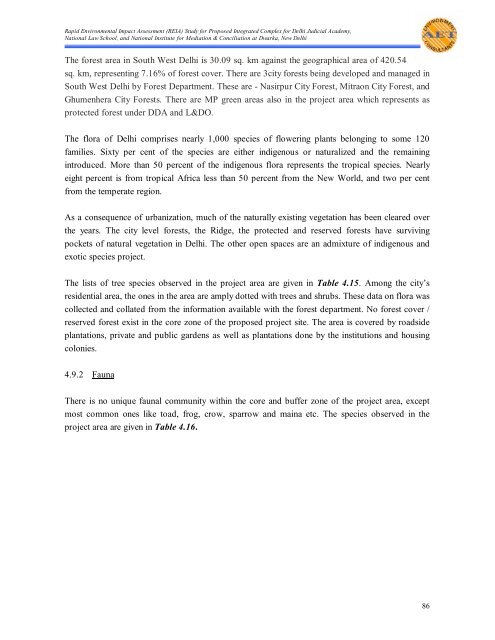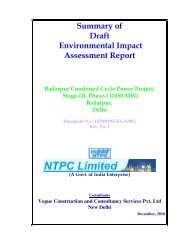proposed integrated complex for delhi judicial academy
proposed integrated complex for delhi judicial academy
proposed integrated complex for delhi judicial academy
You also want an ePaper? Increase the reach of your titles
YUMPU automatically turns print PDFs into web optimized ePapers that Google loves.
Rapid Environmental Impact Assessment (REIA) Study <strong>for</strong> Proposed Integrated Complex <strong>for</strong> Delhi Judicial Academy,<br />
National Law School, and National Institute <strong>for</strong> Mediation & Conciliation at Dwarka, New Delhi<br />
The <strong>for</strong>est area in South West Delhi is 30.09 sq. km against the geographical area of 420.54<br />
sq. km, representing 7.16% of <strong>for</strong>est cover. There are 3city <strong>for</strong>ests being developed and managed in<br />
South West Delhi by Forest Department. These are - Nasirpur City Forest, Mitraon City Forest, and<br />
Ghumenhera City Forests. There are MP green areas also in the project area which represents as<br />
protected <strong>for</strong>est under DDA and L&DO.<br />
The flora of Delhi comprises nearly 1,000 species of flowering plants belonging to some 120<br />
families. Sixty per cent of the species are either indigenous or naturalized and the remaining<br />
introduced. More than 50 percent of the indigenous flora represents the tropical species. Nearly<br />
eight percent is from tropical Africa less than 50 percent from the New World, and two per cent<br />
from the temperate region.<br />
As a consequence of urbanization, much of the naturally existing vegetation has been cleared over<br />
the years. The city level <strong>for</strong>ests, the Ridge, the protected and reserved <strong>for</strong>ests have surviving<br />
pockets of natural vegetation in Delhi. The other open spaces are an admixture of indigenous and<br />
exotic species project.<br />
The lists of tree species observed in the project area are given in Table 4.15. Among the city’s<br />
residential area, the ones in the area are amply dotted with trees and shrubs. These data on flora was<br />
collected and collated from the in<strong>for</strong>mation available with the <strong>for</strong>est department. No <strong>for</strong>est cover /<br />
reserved <strong>for</strong>est exist in the core zone of the <strong>proposed</strong> project site. The area is covered by roadside<br />
plantations, private and public gardens as well as plantations done by the institutions and housing<br />
colonies.<br />
4.9.2 Fauna<br />
There is no unique faunal community within the core and buffer zone of the project area, except<br />
most common ones like toad, frog, crow, sparrow and maina etc. The species observed in the<br />
project area are given in Table 4.16.<br />
86
















